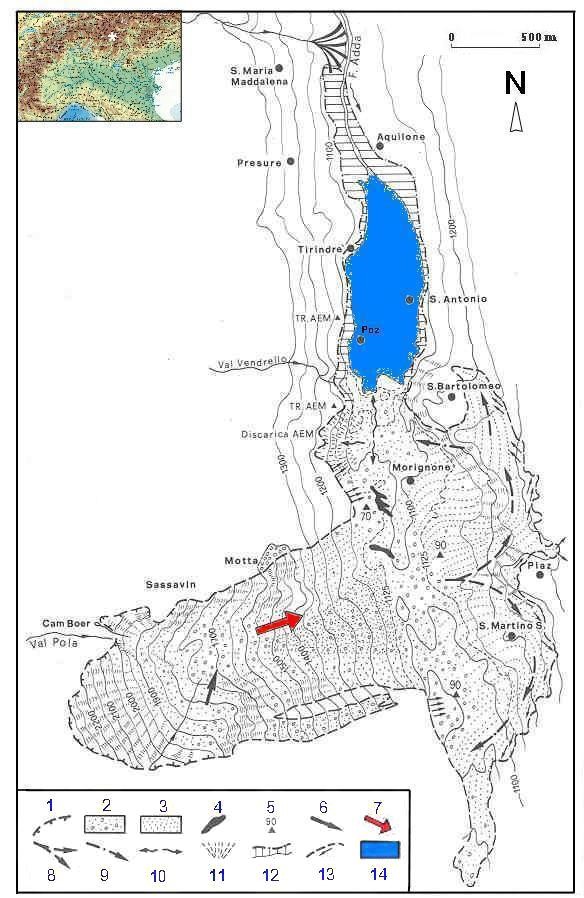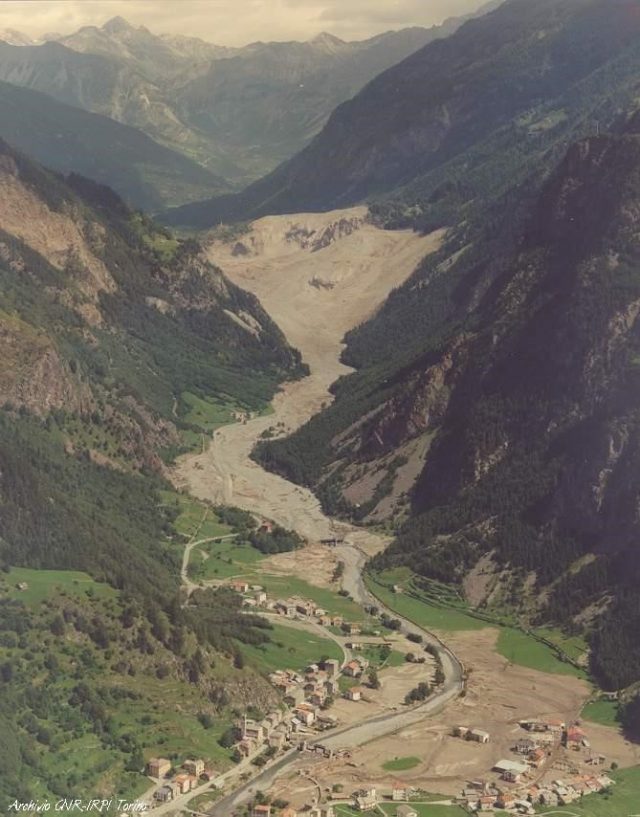30 July 2019
The Mount Zandila (Valpola) rock avalanche
Posted by Dave Petley
The Mount Zandila (Valpola) rock avalanche
This post was kindly provided by Fabio Luino of the Consiglio Nazionale delle Ricerche, Istituto di Ricerca per la Protezione Idrogeologica, Turin, Italy
Email: [email protected].
Introduction
The Mount Zandila landslide (also known as the Valpola rock avalanche) is possibly the most important landslide in Europe in the last 40 years. It occurred on 28th July 1987 in the valley of the Adda River (Valtellina) in the Central Alps, 130 km NE of Milan. The landslide, which involved about 34 million cubic metres of rock, killed 29 people in the valley below. This post is intended to provide a brief overview of this important event.
Geology and geomorphology
The slope of Mount Zandila affected by the rock avalanche is mainly composed of igneous and metamorphic rocks with limited superficial deposits. The outcropping rocks were predominantly diorite, gabbro and orthoquartzite, with lesser amounts of gneiss and amphibolite; moraine, debris and alluvial deposits are generally situated in the less steep areas. The rocks were heavily fractured and deeply etched by erosion and rockfall processes.
Like most Alpine valleys, Valtellina shows the typical features of a glacial valley with a superimposed fluvial morphology. In this zone, the average ridge elevation reaches 2500 to 3000 m, while the valley bottom lies roughly at 1000 to 1100 m.
Pre-existing instability
A prehistoric landslide, identified from archive aerial photographs dating from 1954 to 1981, had previously affected the upper part of the slope between 2100 and 2360 m elevation. This feeature, consisting of a steep unvegetated slope about 100 m long is easily recognisable on the imagery below. This appears to represent the sliding surface of a previous landslide on this slope:-

Archive image of the site of the Mount Zandila landslide. An unvegetated area (marked by arrow) was clearly present prior to the 1987 failure event. This is interpreted as being the scar from an earlier landslide event.
.
The period prior to the failure
Between 15th and 19th July 1987, rainfall in the Valtellina totaled 229 mm, of which 124 mm occurred on 18th July (Govi & Turitto, 1992). Several landslides, mostly soil slips, were triggered on the slopes in the tributary valleys. During the rainstorm of 18th July, the streams on the flanks of the landslide were affected by numerous debris flows, which continued to occur through to midday the following day. The displaced masses dammed the Adda River, creating a lake of almost 100,000 m² about 100 m upstream from the northern border of the incipient landslide.
Three days before the collapse, a discontinuous tension crack was sighted by a guide. The crack ran for about 600 m along the scarp at an altitude of 2200 m, coinciding with the slide surface of the old landslide on the eastern slope of Mount Zandila.
Between 25th and 27th July, several rockfalls on the eastern slope occurred, including 98 falls in only 24 hours the day before the collapse (Govi & Turitto, 1992). Inhabitants from the villages of Morignone, San Antonio, Poz and Tirindrè were evacuated in response.
The collapse event
At 7:23 a.m. on 28th July 1987, a large mass of rock, with a volume of about 34 million m³, detached from the eastern slope of Mount Zandila (Figure 2). The image below shows the source zone of the landslide:

The source area of the 28th July 1987 Mount Zandila landslide.
.
The displaced mass, including the prehistorical slide and the bedrock, moved in two short phases: the first came down as a northward slide of the upper part of the slope (marked 6 in the diagram below), whilst the second occurred in a single rapid displacement towards the east into the Adda valley floor (marked 7 below). This failure inundated the village of Morignone:-

Figure 3 – Interpretative maps of the Mount Zandila rock avalanche. 1) Main scarp; 2) debris mostly coarse blocks; 3) debris mostly fine material; 4) strips of old clayey lacustrine deposits mixed with debris landslide; 5) places of maximum accumulation thickness; 6) falling direction of rock slide; 7) falling direction of rock avalanche; 8) climbing direction on the opposite slope and diversions of the displaced mass; 9) falling back directions; 10) muddy wave drifts; 11) cloudy waters tracks and throwing alluvial debris at AEM waste water; 12) muddy wave tracks at the foot of the slopes; 13) cutting down direction of the trees on the borders of the devastated area; 14) basin upstream the displaced mass (from Govi & Turitto, 1992, modified).
.
The mass roared up the opposite slope of the valley to about 300 m above the valley floor, then split into two parts, diverted upstream and downstream:

General view of the landslide area showing the 2100-m stretch where the valley was dammed. The flow of water in the channel generated a barrier lake. For this reason inhabitants living downstream had to be evacuated, due to the very high risk of an overtopping and breaching of the dam.
.
The mass that moved downstream travelled almost 1400 m from the impact point. The mass plunged into the small lake, displacing alluvial debris and muddy water to a height of 140 metres. The impact unleashed a large wave that moved quickly upstream. Eyewitnesses reported that the wave travelled 1,000 m in about 30 seconds (Govi & Turitto, 1992). Mud marks were surveyed at a maximum height of 95 m near the source, decreasing to 15 m northward at a distance of about 1,300 m. The villages of Poz, San Antonio and Tirindrè were destroyed. More than 2 km upstream, 27 people were killed in the village of Aquilone, which had not been completely evacuated:-

Extent of Mount Zandila rock avalanche. The mass rapidly fell towards the Adda valley bottom destroying Morignone. The material moving upstream fell into the small lake splashing the muddy water and the alluvial materials: a large wave moved very quickly sweeping away the other four villages.
.
Just before the wave impact, survivors saw the bell tower of San Antonio church shatter from the violent blast, which also blew down also the trees of the opposite slope over 300 m.
A dark dust cloud, extending up to 2 km elevation on the opposite side of the valley and upstream to Massaniga creek, was observed. It reportedly disappeared about 20 sec later (Azzoni et al., 1992).
No seismic activity was recorded before the collapse. The landslide generated a seismic signal recorded by instruments over 150 km away for a period of about 30 seconds, comparable to a M=3.9 earthquake (Govi, 1989). The seismograms indicate the detachment of the mass occurred in 18 seconds and the fall in 23 seconds.
The impacts and the remedial works
The valley was dammed by a estimated volume of about 40 million cubic metres more than 2 km long. The average thickness of the accumulation was 30 to 60 m, with a maximum of 90 m:-

The Adda valley floor, looking downstream, after the landslide. The valley was dammed by a debris accumulation 2,100 m long and about 200-700 m wide: the great part of this mass was 30 to 60 m deep, with a maximum local thickness of 90 m. The displaced mass moved up to the opposite slope (on the right), attaining a height of 300 m above the valley floor.
.
It was made up of material ranging in size from fine debris to coarse blocks up to 10 m across (Azzoni et al., 1992), but mostly consisting of deposits from silt-sand to boulders 30 cm in diameter.
The flow of water in the channel upstream from the landslide dam formed a lake. After thirty days, following an intense rainstorm, the lake filled to a volume of about 20 million cubic meters. Downstream inhabitants had to be evacuated, due to the very high risk of an overtopping and breaching of the dam. As an emergency pumping system proved inadequate for reducing the likelihood of overtopping, a spillway was built at the top of the blockage to control the discharge and to evaluate the resistance of landslide dam to down cutting. The induced flow did not cause significant erosion of the dam, probably due to the gentle slope of the spillway. However, the downstream face of the blockage was reinforced and two diversion tunnels were fully opened the following year.
References
Azzoni A., Chiesa S., Frassoni A. & Govi M. (1992) – The Valpola landslide. Engineering Geology, Elsevier Science Publishers B.V., Amsterdam, 33, 59-70
Govi M. (1989) – The 1987 Landslide on Mount Zandila in the Valtellina, northern Italy. Landslide News, Japan landslide Soc., 3, 1-3.
Govi M. & Turitto O. (1992) – La frana di Val Pola del 1987 in alta Valtellina. In Vallario A. “Frane e territorio”, Napoli, Liguori Ed., 392-414.


 Dave Petley is the Vice-Chancellor of the University of Hull in the United Kingdom. His blog provides commentary and analysis of landslide events occurring worldwide, including the landslides themselves, latest research, and conferences and meetings.
Dave Petley is the Vice-Chancellor of the University of Hull in the United Kingdom. His blog provides commentary and analysis of landslide events occurring worldwide, including the landslides themselves, latest research, and conferences and meetings.
Moin moin meine aktiven freunde ihr könntet des mal auf deutsch schreiben damit ihr euch such an den Lebensraum anpasst!